Today is the Open Books, Open Minds “celebration of reading and literacy,” a free virtual event from LJ/SLJ and NCTE. I moderated a panel on “the joy of reading” with five authors:
- Veera Hiranandani (Penguin Young Readers), author of Amil and the After, How to Find What You’re Not Looking For, and The Night Diary, a Newbery Honor book.
- Stuart Gibbs (Simon & Schuster), author of the Spy School, Funjungle, Moon Base Alpha, and Once Upon A Tim series
- Peter Kahn (Penguin Young Readers), poet, educator, and project creator; co-editor of Respect the Mic: Celebrating 20 years of poetry from a Chicagoland High School
- Tanisia “Tee” Moore (Scholastic), author of Micah Hudson: Football Fumble and picture book I Am My Ancestors’ Wildest Dreams
- Claribel Ortega (Scholastic), author of Witchlings, Ghost Squad, and Frizzy, winner of the Massachusetts Children’s Book Award
All of the authors spoke beautifully and passionately about the importance and joy of books and reading. Brief notes on our conversation are below, and the whole day’s worth of panels and presentations will be available for online viewing for the next three months.
What does “the joy of reading” mean to you?
- SG: (holding up a copy of The Westing Game by Ellen Raskin) “Reading creates memories.”
- CO: Reading allows me to go into other people’s lives and experience things I wouldn’t do otherwise.
- TM: “Books transport you.” (Cited The Snowy Day and Nancy Drew mysteries.)
- VH: Books provide companionship.
- PK: When you’re reading a paper book, you can’t multitask. You are in the moment.
How did you come to love reading? 
- TM: Was always a reader, and reading and writing were linked; kept a diary from age 6. Characters in books “were my friends.”
- SG: Always a reader, read a huge number of library books – even found the G section where his book would be if he wrote one someday. [Ed. note: One! Haha]
- VH: Had a lot of free choice, and never felt judged for her reading choices, even when she read comics. Having that freedom was important.
- PK: Saw his parents reading for pleasure on vacation, so perceived it as a fun/leisure activity rather than a forced one.
- CO: Always a reader. Books and libraries provided a safe space.
What about kids who haven’t discovered the joy of reading yet?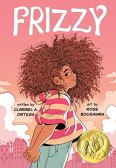
- VH: Again, freedom to choose what you read is important. And parents can model reading, too.
- TM: Allow kids to discover what they enjoy. Read together, or read what they’re reading, and let books start conversations.
- SG: Books should be FUN! Graphic novels can be a gateway to reading other kinds of books.
- PK: Read together, read aloud.
- CO: Kids love graphic novels. Also, if they’re interested in other media (computer games, TV shows, etc.), make a connection to those other interests.
- TM: If there’s a movie or TV version of the book, read/watch both and compare them.
- VH: If kids read when they’re young, then drift away from it, they can come back to it: “It’s IN there.” True for adults too.
What are some ways your books can be, or have been, used in the classroom?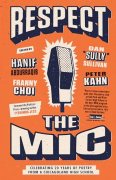
- PK: There is a website with videos to accompany Respect the Mic. Seeing poets perform their own work aloud increases engagement; there are also lesson plans and prompts.
- SG: Did a lot of research for the Charlie Thorne series (partially inspired by reading Michael Crichton, who combined science and adventure), so history is woven in. Notes at the end of the book go some way toward explaining what parts are fact and what is made up, but students are encouraged to do their own research too.
- CO: Witchlings has themes of prejudice, belonging, inequality, and socioeconomic status. Some teachers have asked students to use their problem-solving skills to suggest changes in the fantasy world of the book. What if…?
- TM: I Am My Ancestors’ Wildest Dreams introduces readers to contemporary heroes, expands on Black history, and asks readers to consider when and how to make “good trouble.” It can be used in social studies and during Black History Month.
- VH: Nisha, the protagonist of The Night Diary, and her twin Amil, protagonist of Amil and the After, are twins with very different styles of learning, ways of creating meaning, and ways of expressing themselves. Readers can consider their own and others’ learning styles, meaning-making, and expressions.
Why do you think reading is important, and how do you convey that to young readers?
- SG: Reading about different worlds, cultures, and experiences creates empathy. Reading is a gateway.
- VH: Echoes Rudine Sims Bishop’s “Mirrors, Windows, and Sliding Glass Doors.” Books allow people to enter into others’ lives and gain a deep understanding.
- CO: Books are a place to learn about tough topics safely.
- PK: Having hard (physical, paper) copies of books is more important than ever so that you can focus without distraction, scrolling, notifications.
How do you communicate a message/theme to young readers without being didactic?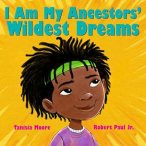
- CO: TRUST your reader. Let things be messy. Some things aren’t fixed – that’s realism. Kids appreciate you being real with them.
- TM: Use dialogue and action to show; allow readers space to figure things out on their own. It’s harder to write a picture book than people imagine!
- SG: A little bit of messaging goes a long way; make it powerful, not repetitive.
- VH: A didactic message reveals an adult agenda.
Is it mandatory to have a child in order to be a good children’s book author? (audience question)
- TM: Most important is to BE A READER of the genre you want to write in. Spend time around kids (doesn’t have to be your own).
- VH: Be in touch with your inner child.
- CO: Talk with kids on school and library visits.
It was such a privilege to speak with these authors today and hear what they had to say about the joy of reading. Library news lately has been dominated by book bans and budget cuts, so to hear kidlit creators speak out so strongly in favor of free choice in reading was marvelous. I believe that kids will build an identity as a reader if they are allowed to choose their books (including graphic novels and audiobooks); if they see the adults in their lives reading books; if they engage in conversations about books. I believe that reading builds empathy, and prepares people to live in the world with other people, and to experience scary things in a safe way.
Happy reading to you all!

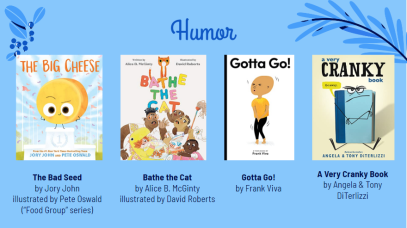















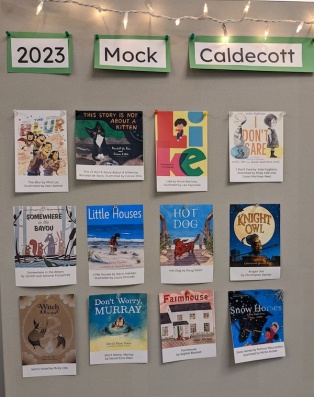 Visual supports: The award is for illustration, after all, so I wanted to create a visual environment to support our Mock Caldecott. Here are a few ways I did that:
Visual supports: The award is for illustration, after all, so I wanted to create a visual environment to support our Mock Caldecott. Here are a few ways I did that:












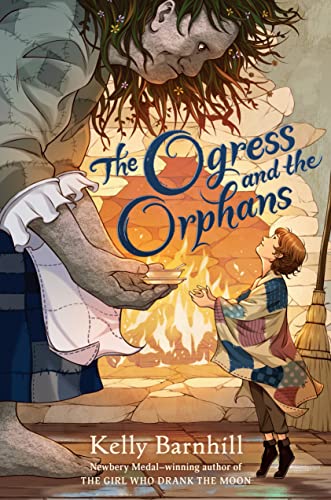































 I can’t imagine anyone was surprised that Unspeakable by Carole Boston Weatherford, illustrated by Floyd Cooper, won two Coretta Scott King awards (for author and for illustrator), as well as a Sibert honor and a Caldecott honor. I’m looking forward to reading CSK illustrator honor book Nina, but I’m really surprised that Christian Robinson’s other 2021 book, Milo Imagines the World, didn’t get any official recognition.
I can’t imagine anyone was surprised that Unspeakable by Carole Boston Weatherford, illustrated by Floyd Cooper, won two Coretta Scott King awards (for author and for illustrator), as well as a Sibert honor and a Caldecott honor. I’m looking forward to reading CSK illustrator honor book Nina, but I’m really surprised that Christian Robinson’s other 2021 book, Milo Imagines the World, didn’t get any official recognition. Other Printz honor books included Starfish by Lisa Fipps (a novel in verse!), Concrete Rose by Angie Thomas, Last Night at the Telegraph Club by Malinda Lo, and Revolution in Our Time by Kekla Magoon (the latter is the only Printz book I hadn’t already read, but it’s on my list now).
Other Printz honor books included Starfish by Lisa Fipps (a novel in verse!), Concrete Rose by Angie Thomas, Last Night at the Telegraph Club by Malinda Lo, and Revolution in Our Time by Kekla Magoon (the latter is the only Printz book I hadn’t already read, but it’s on my list now). I’d actually read a bunch of Sibert honor books, though not the winner; I was super excited to see The Great Stink on the list. We Are Still Here by Traci Sorrell and Unspeakable also got honors, as did Summertime Sleepers (which taught me the word “estivate,” which is like hibernating but in the summer).
I’d actually read a bunch of Sibert honor books, though not the winner; I was super excited to see The Great Stink on the list. We Are Still Here by Traci Sorrell and Unspeakable also got honors, as did Summertime Sleepers (which taught me the word “estivate,” which is like hibernating but in the summer).
















